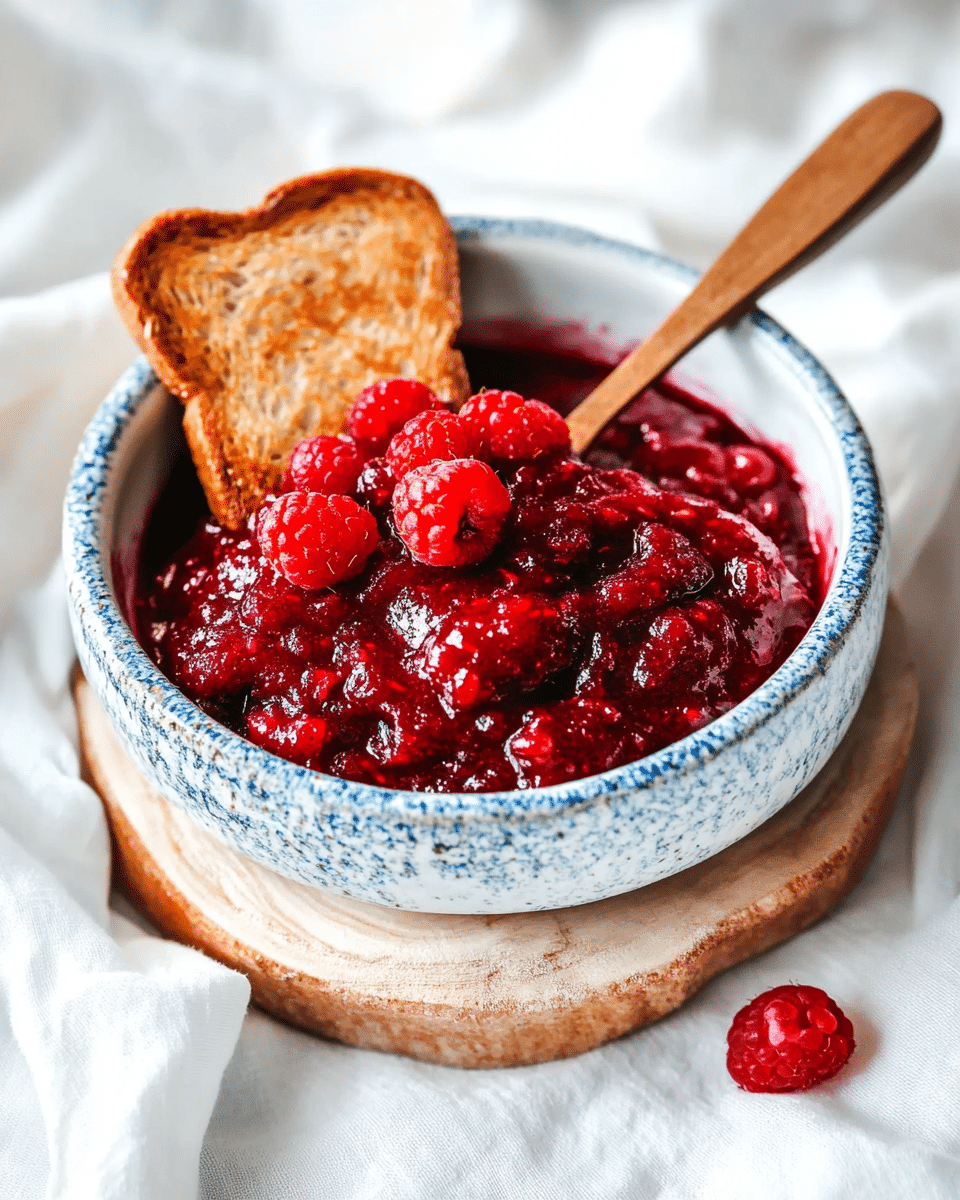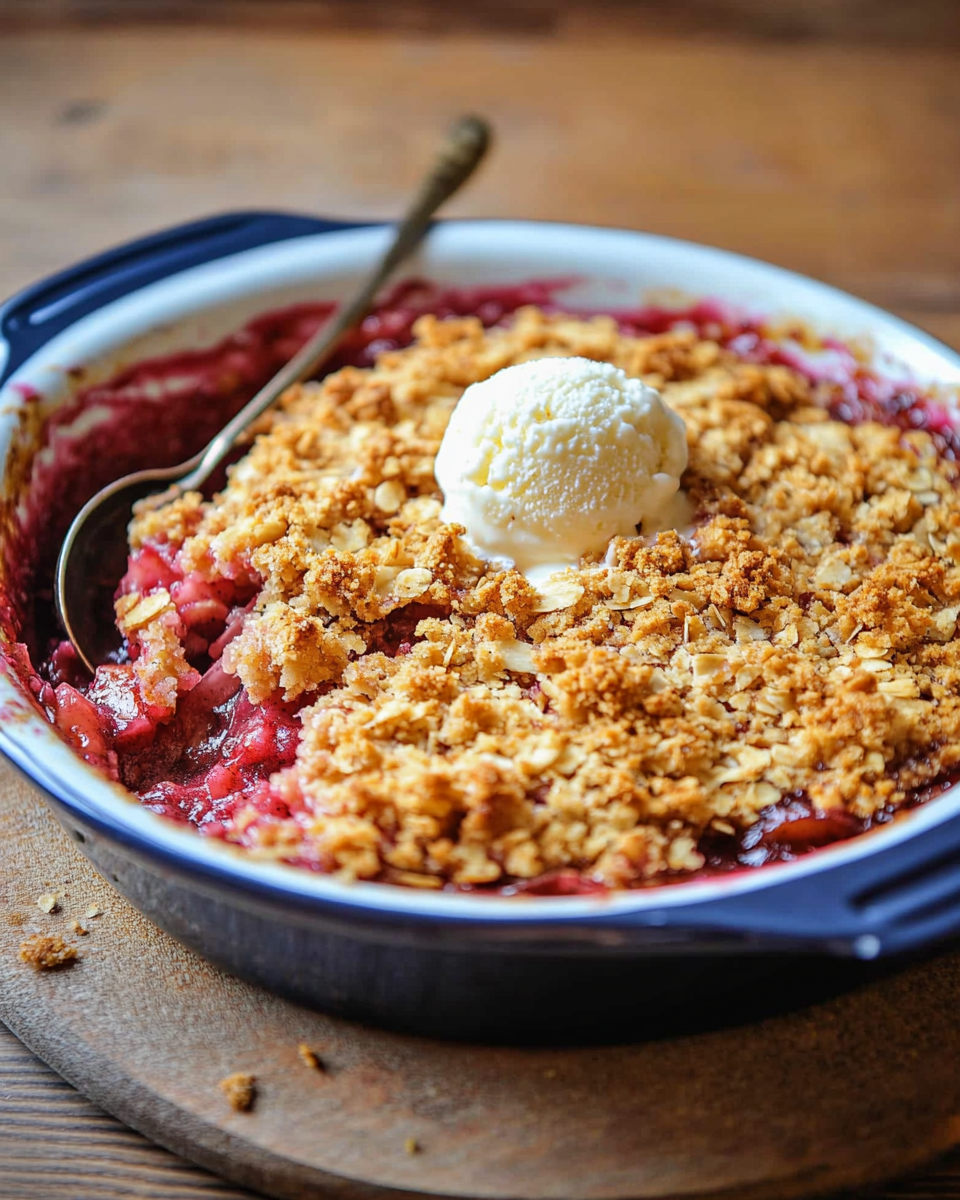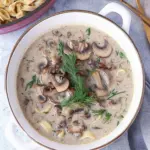A tangy and sweet compote blending tart rhubarb with juicy raspberries, perfect for topping yogurt, pancakes, desserts, or enjoying on its own. This traditional style compote is simple to make and bursting with fresh fruit flavor.
FULL RECIPE
Ingredients
- 3 cups rhubarb, chopped
- 2 cups fresh or frozen raspberries
- 3/4 cup granulated sugar
- 1/4 cup water
- 1 teaspoon lemon juice
- 1/2 teaspoon vanilla extract (optional)
Directions
- In a medium saucepan, combine rhubarb, raspberries, sugar, and water.
- Cook over medium heat, stirring occasionally, until the fruit breaks down and the mixture thickens, about 15-20 minutes.
- Stir in lemon juice and vanilla extract if using.
- Remove from heat and let cool slightly. The compote will thicken more as it cools.
- Serve warm or chilled over your favorite dishes or store in the refrigerator for up to one week.
Nutritional Information
- Calories: 90
- Total Fat: 0g
- Saturated Fat: 0g
- Cholesterol: 0mg
- Sodium: 2mg
- Total Carbohydrates: 23g
- Dietary Fiber: 3g
- Sugars: 19g
- Protein: 1g
- Vitamin A: 2% DV
- Vitamin C: 20% DV
- Calcium: 2% DV
- Iron: 2% DV
The History of Rhubarb Raspberry Compote
Rhubarb raspberry compote has roots that stretch back centuries, traditionally made as a way to preserve seasonal fruits before refrigeration. Rhubarb, originally cultivated in Asia for medicinal purposes, found its culinary niche in Europe and North America where its tartness paired perfectly with sweeter fruits like raspberries. The compote’s simple preparation reflects a longstanding practice of cooking down fruit with sugar to create versatile, shelf-stable preserves. This history gives the dish a nostalgic appeal, connecting modern kitchens to old-world fruit preservation traditions.
The Flavor Profile of Rhubarb Raspberry Compote
The standout characteristic of this compote is its balance of tartness and sweetness. Rhubarb’s natural acidity provides a bright, tangy backbone, while raspberries contribute a rich, fruity sweetness and a slight floral note. The combination creates a refreshing contrast that can enhance a wide range of dishes. The addition of lemon juice brightens the flavors even more, and optional vanilla adds warmth and depth. This layering of flavors makes the compote dynamic yet harmonious on the palate.
Nutritional Benefits of Rhubarb and Raspberries
Both rhubarb and raspberries are nutrient-rich fruits. Rhubarb offers a good source of vitamin K and fiber, which supports bone health and digestion. Raspberries are packed with antioxidants, vitamins C and E, and dietary fiber, known for their anti-inflammatory properties and immune system support. Together, they create a compote that is not only delicious but also a nutritious addition to your diet, delivering vitamins and minerals with relatively low calories.
How to Use Rhubarb Raspberry Compote in Meals
This compote’s versatility makes it a wonderful ingredient to elevate many meals. It can be spooned over breakfast items like pancakes, waffles, or oatmeal for a fresh fruit topping. It also pairs well with yogurt or cottage cheese, adding natural sweetness and texture. For desserts, it complements vanilla ice cream, cheesecake, or pound cake beautifully. Additionally, it can be used as a condiment alongside savory dishes like roasted pork or grilled chicken, providing a sweet-tart counterpoint.
Seasonal Availability and Freshness
Rhubarb is typically harvested in the spring and early summer, while raspberries peak slightly later in summer. Using fresh, in-season fruit for this compote ensures optimal flavor and texture. However, frozen raspberries can be used year-round, maintaining good flavor and convenience. Fresh rhubarb should be firm and brightly colored, while raspberries should be plump and fragrant. Proper selection of ingredients greatly influences the final quality of the compote.
Storing and Shelf Life
When properly stored in an airtight container in the refrigerator, rhubarb raspberry compote can last up to one week. For longer storage, freezing the compote is a great option; it will keep well for up to six months. To freeze, place the cooled compote in freezer-safe containers or bags, leaving space for expansion. When ready to use, thaw in the refrigerator or gently warm on the stove. This makes it easy to enjoy seasonal flavors year-round.
Variations and Customizations
The basic rhubarb raspberry compote recipe is flexible and can be customized in many ways. Adding spices like cinnamon, ginger, or cardamom can introduce warm, aromatic notes. For a more textured compote, some cooks like to add chopped apples or pears. Sweeteners can also be varied—from honey and maple syrup to alternative sugars—for different flavor profiles and dietary needs. Adjusting the sugar level can make the compote more or less sweet depending on preference.
Pairing Rhubarb Raspberry Compote with Other Foods
Because of its tart and sweet flavor, this compote pairs excellently with both sweet and savory foods. It complements creamy textures such as mascarpone, ricotta, or cream cheese, making it a perfect spread or dip for crackers and bread. In savory applications, it balances rich meats like pork belly, duck, or even fatty cheeses such as brie and camembert. It also enhances salads, adding a fruity burst to mixed greens and nuts.
Cooking Tips for the Best Texture
Achieving the perfect texture for rhubarb raspberry compote means cooking just until the fruit breaks down but not so much that it turns mushy. Stirring occasionally ensures even cooking and prevents burning. If a thicker compote is desired, cooking longer or adding a small amount of cornstarch slurry can help. Conversely, a looser sauce can be made by reducing cooking time or adding a splash of water or fruit juice. Experimenting with cooking times lets you tailor the texture to your needs.
Health Considerations and Dietary Adaptations
Rhubarb raspberry compote is naturally gluten-free, dairy-free, and vegan, making it suitable for many dietary restrictions. For those watching sugar intake, the amount of added sugar can be reduced or replaced with natural sweeteners. Since rhubarb leaves contain oxalic acid and are toxic, only the stalks are used in cooking. This compote offers a healthy alternative to processed jams or syrups, giving you control over ingredients and added sugars.
The Role of Rhubarb in Culinary Traditions
Rhubarb is often celebrated in culinary traditions as a springtime ingredient, valued for its unique tartness. In British and American cuisine, rhubarb is a classic in pies, crumbles, and preserves, frequently combined with sweeter fruits like strawberries or raspberries. This compote embodies that tradition by focusing on the complementary pairing of rhubarb and raspberry, showcasing the ability of rhubarb to transform simple fruit dishes into something vibrant and memorable.
Serving Suggestions for Entertaining
Rhubarb raspberry compote is a wonderful addition to any entertaining menu. Served alongside cheese boards, it provides a fresh and fruity contrast to cured meats and cheeses. It can also be presented as part of a dessert buffet with ice cream, cakes, or panna cotta. For breakfast or brunch gatherings, offer it as a topping for crepes, yogurt parfaits, or French toast. Its eye-catching color and rich flavor make it a crowd-pleaser.
Conclusion
Rhubarb raspberry compote is a timeless, versatile fruit preserve that combines nutrition, flavor, and tradition in one simple dish. Its bright tartness balanced by sweetness makes it suitable for a wide array of culinary uses—from breakfast to dessert and even savory pairings. Easy to prepare and adaptable to personal tastes, this compote brings the freshness of seasonal fruits to the table and allows for creative expression in the kitchen. Whether served warm or chilled, it offers a delightful way to enjoy the best of rhubarb and raspberries throughout the year.








